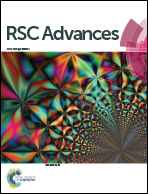Study of captopril pharmacokinetics in rabbit blood with microdialysis based on online generated Au nanoclusters and pepsin–captopril interaction in luminol chemiluminescence
Abstract
A luminol–HAuCl4–pepsin (Pep) flow injection-chemiluminescence (FI-CL) system was explored to determine captopril (CAP) based on the CL intensity inhibition effect and applied to study CAP pharmacokinetics in rabbits with microdialysis. HAuCl4 and pepsin (Pep) could significantly enhance the luminol chemiluminescence (CL) intensity. It was found that sub-nanometre Au nanoclusters (AuNCs) were generated in the luminol–HAuCl4–Pep reaction solution. A possible mechanism for AuNCs generation is given. By means of the FI-CL and molecular docking (MD) methods, the Pep–CAP interaction was systematically studied. The results showed that CAP might enter into Pep active site Asp32 with the binding constant (K) 1.7 × 106 L mol−1, which could effectively inhibit the CL intensity. The CL intensity could be remarkably inhibited by CAP and the decrement of CL intensity was linearly correlated to the logarithm of CAP concentration in the range of 3.0 pmol L−1 to 0.1 μmol L−1, with a detection limit of 1.0 pmol L−1 (3σ). This proposed approach was successfully applied to determine CAP in rabbit’s blood during the 16 h after intragastric administration with an elimination ratio of 45.9% and recovery ratios from 89.0% to 112.0%. The pharmacokinetic results showed that CAP could be rapidly absorbed into blood with a peak concentration (Cmax) of 9.63 ± 1.45 μg mL−1 at a maximum peak time (Tmax) of 0.75 ± 0.08 h; the elimination half-life of 3.19 ± 0.13 h and the elimination rate constant of 7.27 ± 0.41 L g−1 h−1 in rabbits were derived, respectively.


 Please wait while we load your content...
Please wait while we load your content...